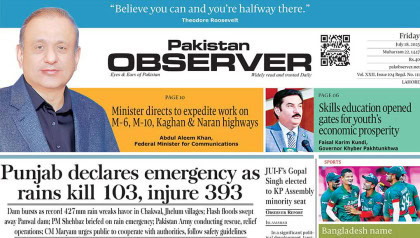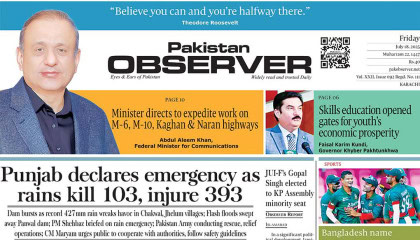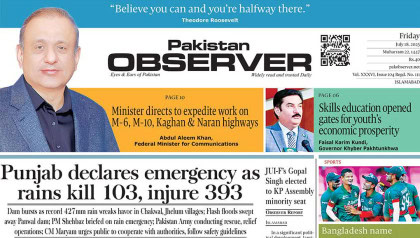UNFORTUNATELY, a new trade war is on the brink.
The protectionist and anti-globalised tariffs, recently announced by President Trump “fundamentally change the international trading system”.
The increased tariffs represent a significant shift in global economics, entailing various cross-currents, impacting trade relationships and potentially leading to retaliatory measures.
The experts argue that Trump’s tariff policies are highly politicized, using tariffs as an economic weapon.
Though Trump has stated his belief that tariffs will make America richer, the leitmotif of Trump’s centripetal tariff policy is to pivot the world as US-centric.
Critics accuse that in his quest to make America economically stronger, Trump is rendering other states weaker and more unstable.
Recently, the Trump Administration has imposed tariffs on 186 countries, particularly the developing countries will face short- and long-term economic impacts.
Short-term effects include fluctuating prices, potentially reducing consumer spending and economic growth.
Disrupted supply chains and increased production costs for businesses are also likely.
Long-term effects, based on historical data, suggest reduced output, decreased productivity, increased unemployment and worsened inequality.
Economic experts indoctrinate that a real trade policy –is not about orchestrating pressures over others, resulting in creating client states–rather, it should be fundamentally ‘’about organizing the natural impulse of global societies everywhere to trade goods and services in a way that makes the world more prosperous, secure and sustainable.’’
President Trump’s proposed policies include a 10% tariff on all nations and increased rates up to 50% on specific countries, along with already implemented tariffs, such as 25% on imports from Canada and Mexico.
These measures are aimed at boosting the US economy and protecting American industries.
His actions highlight how trade policy is integrated into political and economic strategies.
The severity of these impacts depends on the specific tariffs imposed and the affected country’s economic structure.
The tariffs ranging from 10% (Britain) to 49% (Cambodia) indicates that the impact is not uniform.
The drastic trade measures, which the Trump Administration embraces as “Liberation Day” for the US, reach far beyond the country’s trade imbalance with China’’.
In response to Trump’s tariff trajectory, Beijing has imposed a 125% tariff on American goods; whereas Washington has imposed a 145% tariff on Chinese commodities.
But experts warn that coercing China could backfire, given Beijing’s intercontinental economic leverage and its expanding influence over the European markets.
In essence, this policy, which some call a mixture of opposites, blending elements that seems contradictory, undermines the globalization goals and the WTO‘s norms by violating international trade rules and potentially triggering retaliatory measures.
Imposing unjust tariffs on developing states profoundly challenges established global trade laws.
These actions infringe upon the rights of other parties and may escalate into trade wars.
It is fairly argued that the use of tariffs as leverage, rather than adherence to WTO guidelines, further destabilizes the international trade system.
Such strategies often lead to reciprocal tariffs, causing further disruptions.
Moreover, Asian trading partners of the US are now subject to significant tariffs, with some facing rates up to 49%.
This impacts nations that have relied on US markets for economic growth through exports.
Needless to say, US’ tariff policies create instability in the European markets, including the Eurozone.
The EU, as a major trading partner, could face considerable economic consequences from such protectionist policies, disturbing trade flows while increasing costs for businesses and consumers within the EU.
Though the European Union has imposed a 25% retaliatory tariff, German Finance Minister Jörg Kukies recently proposed a free trade area between the US and the EU, effectively reducing tariffs to zero for both sides.
But this proposal requires marathon negotiations.
Moreover, American economic experts warn that Trump’s tariff policies, which imposed taxes on imports, are expected to negatively impact the US economy.
Economists predict that tariffs will lead to higher prices and potentially slower economic growth.
This could indirectly affect political relations as trade disputes can arise from tariffs, leading to strained relationships with countries affected by these policies.
The economic strain caused by tariffs, such as increased costs for businesses and consumers and the risk of a recession, may also influence political dynamics and global perceptions of the United States.
US-G7 relations are strained due to new tariff.
The economic indicators reveal that domestically Trump’s tariff policy would likely lead to significant gross tariff revenues.
Estimates suggest potential revenues in the trillions of dollars.
However, the impact extends beyond just revenue generation.
Increased tariffs can influence net federal revenues and potentially reduce overall economic activity, such as a reduction in gross domestic product.
And also, Trump’s tariff policies are likely to negatively impact both India and Pakistan.
Increased tariffs on Pakistani goods threaten their price competitiveness, especially when compared to countries like India, Bangladesh and Vietnam.
These higher tariffs could lead to price increases, reduced exports and potential job losses in various sectors.
Trump’s trade policy significantly increased tariffs on Pakistani exports reduces the profitability of Pakistani businesses.
The rise to 29% from a previous 4-5% threatens the price competitiveness of Pakistani goods.
Proactively, the Pakistani government is committed to negotiating a 29% tariff with the US government, promoting trade relations between the two countries, aiming to mitigate the growing trade challenges and mutually strengthening the economic ties between the US and Pakistan.
To conclude, devising a balanced trade policy in a hypercompetitive world is indeed a significant challenge.
Thus, the Trump administration’s policymakers must reshape the contours of global commerce to appropriately address the negative impacts of these tariffs.
—The writer, based in Pakistan, an independent IR & International Law analyst, also an expert in Conflict and Peace Studies (with special focus on Palestine, Kashmir), is member of European Consortium of Political Research (ECPR), including the Washington Foreign Law Society/American Society of International Law. (rizvipeaceresearcher@gmail.com)



















